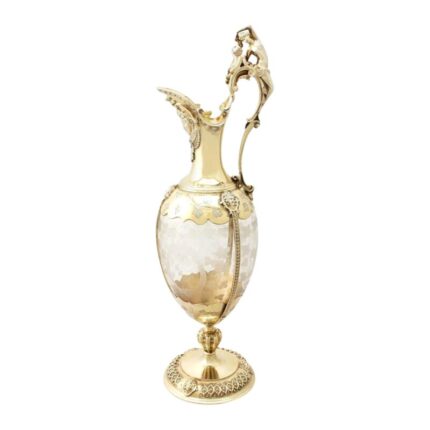A tall ceramic satsuma ware vase in a rare slender trumpet form with very fine surface decoration by Japanese potter Taizan Yohei (1864-1922). The vase was dated to late Meiji period circa 1890-1900s.
The main motif and the focal point of the vase is the continuous panel that circumvents the entire mid-body, apparently a rendition of the Boy’s Festival, known as “Tango no Sekku” in Japanese. The traditional festival is celebrated on May 5th of each year. Originated in Nara Period (710-794), the ancient holiday was the day to pray for the good fortune, health and success of the male offsprings in the households. The elaborate decoration shows a large number of boys, all dressed in distinct attires, densely packed in a parade. Each individually styled, the boys are engaged in different poses, some with props, some interacting with each other, providing a snap picture of the joyful day. The upper part of the vase shows four round cartouches on a mixed geometrical background, each a vignette of arrangement of flowers, plants and birds, The lower part of the vase features three cartouches in a similar fashion. Both the mouth and base rim were superfluously decorated with scrolls of various motifs, including Greek keys, moriage vines and fleur-de-lis. The entire surface of the glaze has a uniform fine crackle. Within the mouth as well as the base, the glaze appears to have some fine black powder mixed in that forms a subtle swirl pattern. We are not sure if this was intended by artist or occurred during the kiln firing by chance, but it was clearly as made. An impressed mark of “Taizan” was placed at the interior base as shown.
Fine work like this vase is uncommon among the existing Taizan’s work. This vase is likely dated to early period of his career before he started working with Kinkozan. Taizan Yohei (Taizan IX) was adopted in 1878 into the Taizan family, a potter family active as early as 1670s. In 1872, Taizan VIII started to export of their products together with Kinkozan IV. Taizan IX continued to expand the family business and collaborate with Kinkozan until 1894 and possibly later until 1900s but at a smaller scale. His work with Kinkozan was mostly known in the west where they often co-signed the work.
The main motif and the focal point of the vase is the continuous panel that circumvents the entire mid-body, apparently a rendition of the Boy’s Festival, known as “Tango no Sekku” in Japanese. The traditional festival is celebrated on May 5th of each year. Originated in Nara Period (710-794), the ancient holiday was the day to pray for the good fortune, health and success of the male offsprings in the households. The elaborate decoration shows a large number of boys, all dressed in distinct attires, densely packed in a parade. Each individually styled, the boys are engaged in different poses, some with props, some interacting with each other, providing a snap picture of the joyful day. The upper part of the vase shows four round cartouches on a mixed geometrical background, each a vignette of arrangement of flowers, plants and birds, The lower part of the vase features three cartouches in a similar fashion. Both the mouth and base rim were superfluously decorated with scrolls of various motifs, including Greek keys, moriage vines and fleur-de-lis. The entire surface of the glaze has a uniform fine crackle. Within the mouth as well as the base, the glaze appears to have some fine black powder mixed in that forms a subtle swirl pattern. We are not sure if this was intended by artist or occurred during the kiln firing by chance, but it was clearly as made. An impressed mark of “Taizan” was placed at the interior base as shown.
Fine work like this vase is uncommon among the existing Taizan’s work. This vase is likely dated to early period of his career before he started working with Kinkozan. Taizan Yohei (Taizan IX) was adopted in 1878 into the Taizan family, a potter family active as early as 1670s. In 1872, Taizan VIII started to export of their products together with Kinkozan IV. Taizan IX continued to expand the family business and collaborate with Kinkozan until 1894 and possibly later until 1900s but at a smaller scale. His work with Kinkozan was mostly known in the west where they often co-signed the work.
-
Dimensions:Height: 9.5 in (24.13 cm)Diameter: 4.125 in (10.48 cm)
-
Style:Meiji(Of the Period)
-
Materials and Techniques:CeramicEnameled
-
Place of Origin:Japan
-
Period:1880-1889
-
Date of Manufacture:1890s-1900s
-
Condition:GoodWear consistent with age and use. Fine condition with occasional small surface mark and minimal shelf wear. The glaze over the mouth and base interior shows fine black powder in swirling pattern as shown. Not from postproduction or restoration. Examined under UV.
-
Seller Location:Atlanta, GA
-
Reference Number:Seller: LU945041015882
Reviews (0)


























































Reviews
There are no reviews yet.